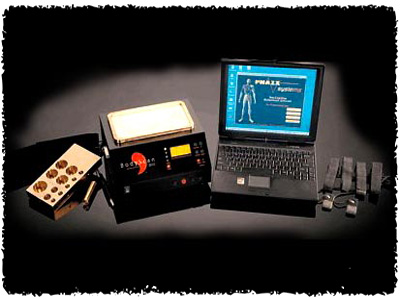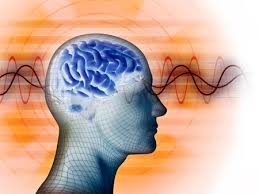Biofeedback
- Details

Biofeedback is a technique in which people are trained to improve their health by learning to control certain internal bodily processes that normally occur involuntarily, such as heart rate blood pressure, muscle tension, and skin temperature.
These activities can be measured with electrodes and displayed on a monitor that both the participant and his or her practitioner can see. The monitor provides feedback to the participant about the internal workings of his or her body. This person can then be taught to use this information to gain control over these "involuntary" activities. Biofeedback is an effective therapy for many conditions, but it is primarily used to treat high blood pressure, tension headache, migraine headache, chronic pain, and urinary incontinence.
Are there different types of biofeedback?
The three most commonly used forms of biofeedback therapy are:
-
Electromyography (EMG), which measures muscle tension
-
Thermal biofeedback, which measures skin temperature
-
Neurofeedback or electroencephalography (EEG), which measures brain wave activity
How does biofeedback work?
Scientists are not able to explain exactly how or why biofeedback works. However, there does seem to be at least one common thread: most people who benefit from biofeedback have conditions that are brought on or made worse by stress. For this reason, many scientists believe that relaxation is key to successful biofeedback therapy. When a body is repeatedly stressed, internal processes like blood pressure become overactive. Guided by a biofeedback therapist, a person can learn to lower his or her blood pressure through relaxation techniques and mental exercises. When a person successfully relaxes and lowers his or her blood pressure, the feedback signals reflect this accomplishment. This acts as affirmation and encouragement for the person's continued efforts.
What is biofeedback good for?
Various forms of biofeedback appear to be effective for a range of health problems. For example, biofeedback shows considerable promise for the treatment of urinary incontinence, which affects over 15 million Americans. Many people prefer biofeedback over medicine because of the lack of side effects. One early study found that biofeedback improves bladder function and reduces symptoms of urinary incontinence by up to 94 percent. Based on these and other findings, the Agency for Health Care Policy and Research has recommended biofeedback therapy as a treatment for urinary incontinence. Biofeedback also appears to be helpful for people with fecal incontinence.
Research also suggests that thermal biofeedback may soothe the symptoms of Raynaud's disease (a condition that causes diminished blood flow to fingers, toes, nose or ears) while EMG biofeedback has been shown to reduce pain, morning stiffness, and the number of tender points in people with fibromyalgia. In addition, a review of scientific studies found that biofeedback may help people with insomnia fall asleep.
In addition, one preliminary study found that the combination of temperature biofeedback and EEG neurofeedback helped alcoholics feel less depressed and more likely to abstain from drinking alcohol.
Biofeedback can also be used effectively for certain ailments in children. For example, EEG neurofeedback (especially when combined with cognitive therapy) has been shown to improve behavior and intelligence scores in children with attention deficit/hyperactivity disorder (ADHD). Biofeedback combined with fiber may also help relieve abdominal pain in children. Thermal biofeedback helps well alleviate migraine and chronic tension headaches among children and adolescents as well.
Biofeedback may also be useful for the following health problems:
| anorexia nervosa | anxiety | asthma |
| autism | back pain | bed wetting |
| chronic pain | constipation | depression |
| diabetes | fecal incontinence | head injuries |
| high blood pressure | learning disabilities | motion sickness |
| muscle spasms | epilepsy and related seizure disorders | |
| spinal cord injuries | sexual disorders, including pain with intercourse | |
How many sessions will I need?
Each session generally lasts less than one hour. The number of sessions required depends on the condition being treated. Many people begin to see results within 8 to 10 sessions. Treatment of headache, incontinence, and Raynaud's disease (as mentioned a condition that causes diminished blood flow to the fingers, toes, nose, or ears) requires at least 10 weekly sessions and then less frequent sessions as health improves. Conditions like high blood pressure, however, usually require 20 weekly biofeedback sessions before improvement can be seen. In addition to these sessions, you will also be taught mental exercises and relaxation techniques that can be done at home and must be practiced at least 5 to 10 minutes every day.
Are there any risks associated with biofeedback?
Biofeedback is considered a safe procedure. No negative side effects have been reported.
How can I find a qualified practitioner?
Specialists who provide biofeedback training range from psychiatrists and psychologists to nurses, dentists, and physicians. The Association for Applied Psychology and Biofeedback (AAPB) is the national membership association for professionals using biofeedback and is a good resource for finding qualified biofeedback practitioners in your area. The AAPB website (www.aapb.org) features a searchable public online directory of practitioners.
Source Here
Is Biofeedback For You?
 Biofeedback is a treatment technique in which people are trained to improve their health by using signals from their own bodies. Physical therapists use biofeedback to help stroke victims regain movement in paralyzed muscles. Psychologists use it to help tense and anxious clients learn to relax. Specialists in many different fields use biofeedback to help their patients cope with pain.
Biofeedback is a treatment technique in which people are trained to improve their health by using signals from their own bodies. Physical therapists use biofeedback to help stroke victims regain movement in paralyzed muscles. Psychologists use it to help tense and anxious clients learn to relax. Specialists in many different fields use biofeedback to help their patients cope with pain.
Chances are you have used biofeedback yourself. You've used it if you have ever taken your temperature or stepped on a scale. The thermometer tells you whether you're running a fever, the scale whether you've gained weight. Both devices "feed back" information about your body's condition. Armed with this information, you can take steps you've learned to improve the condition. When you're running a fever, you go to bed and drink plenty of fluids. When you've gained weight, you resolve to eat less and sometimes you do.
Clinicians reply on complicated biofeedback machines in somewhat the same way that you rely on your scale or thermometer. Their machines can detect a person's internal bodily functions with far greater sensitivity and precision than a person can alone. This information may be valuable. Both patients and therapists use it to gauge and direct the progress of treatment.
For patients, the biofeedback machine acts as a kind of sixth sense which allows them to "see" or "hear" activity inside their bodies. One commonly used type of machine, for example, picks up electrical signals in the muscles. It translates these signals into a form that patients can detect: It triggers a flashing light bulb, perhaps, or activates a beeper every time muscles grow more tense. If patients want to relax tense muscles, they try to slow down the flashing or beeping.
Like a pitcher learning to throw a ball across a home plate, the biofeedback trainee, in an attempt to improve a skill, monitors the performance. When a pitch is off the mark, the ballplayer adjusts the delivery so that he performs better the next time he tries. When the light flashes or the beeper beeps too often, the biofeedback trainee makes internal adjustments which alter the signals. The biofeedback therapist acts as a coach, standing at the sidelines setting goals and limits on what to expect and giving hints on how to improve performance.
The Beginnings of Biofeedback
The word "biofeedback" was coined in the late 1960s to describe laboratory procedures then being used to train experimental research subjects to alter brain activity, blood pressure, heart rate, and other bodily functions that normally are not controlled voluntarily. At the time, many scientists looked forward to the day when biofeedback would give us a major degree of control over our bodies. They thought, for instance, that we might be able to "will" ourselves to be more creative by changing the patterns of our brainwaves. Some believed that biofeedback would one day make it possible to do away with drug treatments that often cause uncomfortable side effects in patients with high blood pressure and other serious conditions.
Today, most scientists agree that such high hopes were not realistic. Research has demonstrated that biofeedback can help in the treatment of many diseases and painful conditions. It has shown that we have more control over so-called involuntary bodily function than we once though possible. But it has also shown that nature limits the extent of such control. Scientists are now trying to determine just how much voluntary control we can exert.
How is Biofeedback Used Today?
Clinical biofeedback techniques that grew out of the early laboratory procedures are now widely used to treat an ever-lengthening list of conditions. These include:
- Migraine headaches, tension headaches, and many other types of pain
- Disorders of the digestive system
- High blood pressure and its opposite, low blood pressure
- Cardiac arrhythmias (abnormalities, sometimes dangerous, in the rhythm of the heartbeat)
- Raynaud's disease (a circulatory disorder that causes uncomfortably cold hands)
- Epilepsy
- Paralysis and other movement disorders
Specialists who provide biofeedback training range from psychiatrists and psychologists to dentists, internists, nurses, and physical therapists. Most rely on many other techniques in addition to biofeedback. Patients usually are taught some form of relaxation exercise. Some learn to identify the circumstances that trigger their symptoms. They may also be taught how to avoid or cope with these stressful events. Most are encouraged to change their habits, and some are trained in special techniques for gaining such self-control. Biofeedback is not magic. It cannot cure disease or by itself make a person healthy. It is a tool, one of many available to health care professionals. It reminds physicians that behavior, thoughts, and feelings profoundly influence physical health. And it helps both patients and doctors understand that they must work together as a team.
Patients' Responsibilities
Biofeedback places unusual demands on patients. They must examine their day-to-day lives to learn if they may be contributing to their own distress. They must recognize that they can, by their own efforts, remedy some physical ailments. They must commit themselves to practicing biofeedback or relaxation exercises every day. They must change bad habits, even ease up on some good ones. Most important, they must accept much of the responsibility for maintaining their own health.
How Does Biofeedback Work?
Scientists cannot yet explain how biofeedback works. Most patients who benefit from biofeedback are trained to relax and modify their behavior. Most scientists believe that relaxation is a key component in biofeedback treatment of many disorders, particularly those brought on or made worse by stress. Their reasoning is based on what is known about the effects of stress on the body. In brief, the argument goes like this: Stressful events produce strong emotions, which arouse certain physical responses. Many of these responses are controlled by the sympathetic nervous system, the network of nerve tissues that helps prepare the body to meet emergencies by "flight or fight."
The typical pattern of response to emergencies probably emerged during the time when all humans faced mostly physical threats. Although the "threats" we now live with are seldom physical, the body reacts as if they were: The pupils dilate to let in more light. Sweat pours out, reducing the chance of skin cuts. Blood vessels near the skin contract to reduce bleeding, while those in the brain and muscles dilate to increase the oxygen supply. The gastrointestinal tract, including the stomach and intestines, slows down to reduce the energy expensed in digestion. The heart beats faster, and blood pressure rises. Normally, people calm down when a stressful event is over especially if they have done something to cope with it. For instance, imagine your own reactions if you're walking down a dark street and hear someone running toward you. You get scared. Your body prepared you to ward off an attacker or run fast enough to get away. When you do escape, you gradually relax.
If you get angry at your boss, it's a different matter. Your body may prepare to fight. But since you want to keep your job, you try to ignore the angry feelings. Similarly, if on the way home you get stalled in traffic, there's nothing you can do to get away. These situations can literally may you sick. Your body has prepared for action, but you cannot act. Individuals differ in the way they respond to stress. In some, one function, such as blood pressure, becomes more active while others remain normal. Many experts believe that these individual physical responses to stress can become habitual. When the body is repeatedly aroused, one or more functions may become permanently overactive. Actual damage to bodily tissues may eventually result.
Biofeedback is often aimed at changing habitual reactions to stress that can cause pain or disease. Many clinicians believe that some of their patients and clients have forgotten how to relax. Feedback of physical responses such as skin temperature and muscle tension provides information to help patients recognize a relaxed state. The feedback signal may also act as a kind of reward for reducing tension. It's like a piano teacher whose frown turns to a smile when a young musician finally plays a tune properly.
The value of a feedback signal as information and reward may be even greater in the treatment of patients with paralyzed or spastic muscles. With these patients, biofeedback seems to be primarily a form of skill training like learning to pitch a ball. Instead of watching the ball, the patient watches the machine, which monitors activity in the affected muscle. Stroke victims with paralyzed arms and legs, for example, see that some part of their affected limbs remains active. The signal from the biofeedback machine proves it. This signal can guide the exercises that help patients regain use of their limbs. Perhaps just as important, the feedback convinces patients that the limbs are still alive. This reassurance often encourages them to continue their efforts.
Should You Try Biofeedback?
If you think you might benefit from biofeedback training, you should discuss it with your physician or other health care professional, who may wish to conduct tests to make certain that your condition does not require conventional medical treatment first. Responsible biofeedback therapists will not treat you for headaches, hypertension, or most disorders until you have had a thorough physical examination. Some require neurological tests as well.
How do you find a biofeedback therapist? First, ask your doctor or dentist, or contact the nearest community health center, medical society, or State biofeedback society for a referral. The psychology or psychiatry departments at nearby universities may also be able to help you. Most experts recommend that you consult only a health care professional a physician, psychologist, psychiatrist, nurse, social worker, dentist, physical therapist, for example who has been trained to use biofeedback.
Source Here
Liked this article? Dive deeper into personal growth and wellness! Check out CrystalWind.ca for spiritual wisdom or explore AromaWorx.ca for natural well-being tips. Spread the positivity—share this with friends on their happiness journey!
Let’s Chat! Drop Your Thoughts Below! ![]()
Disclaimer Health
All post and information provided within this blog is for educational and informational purposes only, and is not to be construed as medical advice or instruction. No action should be taken solely on the contents of this website. Please consult with your healthcare professional before making any dietary or lifestyle changes or taking supplements that may interfere with medications. Any products or information discussed are not intended to diagnose, prevent, treat or cure any illness, disease or lifestyle. Please consult your physician or a qualified health professional on any matters regarding your health and wellbeing or on any opinions expressed within this website.
Latest Articles

Imagine a world of inspiration and healing, free for all—made possible by YOU!
Donate Now—Ignite the Magic at CrystalWind.ca!

Epilepsy - Finding A Cure
Your donation can make a difference!
Help us find a cure – donate now!
Unlock Your Light: Join Lightworkers Worldwide on CrystalWind.ca!
Follow Us!
Biofeedback: Dr. Deborah Stokes
Drug free treatment for Migraines Headaches - Dr. Deborah Stokes
Mike Cohen, from the Center for Brain Training in Florida, describes what biofeedback is and the ways it can help people gain better control and a healthier central nervous system. A tremendous amount of research supports the benefits of biofeedback therapy for a variety of situation like migraines, headaches, anxiety, sports performance, and more.
Biofeedback: NASA Launchpad
Featured This Month
Peridot: The Healer's Stone
Peridot has been used as a Power Stone for centuries. Peridot fosters emotio... Read more
Virgo Mythology
The Virgo Myth In all of constellation mythology, few legends are as misund... Read more
Mabon in Modern Times: Fresh Takes on the Au…
The Mabon season begins somewhere around the 21st-22nd of September and cont... Read more
The Vine: September 2nd - September 29th
The Autumnal Equinox ( Alban Elfed ) Celtic Symbol : The White Swan Read more
Crystals for Virgo
As the warmth of summer begins to soften into the crispness of autumn, the Sun... Read more
Sun in Virgo
An Overview of Sun Sign Characteristics for Virgo Virgo is guided by Mercur... Read more
Mabon Magic: Ideas For Fall Decoration And R…
Welcome (almost!) to Fall! We’re turning the Great Wheel once again, toward ... Read more
Watermelon Tourmaline
Synonym: Rainbow Tourmaline The watermelon tourmaline is a rare variety t... Read more
Sweet Violet
Sweet Violet Faithfulness and modesty. “I will always be true to you.” Helps... Read more













































